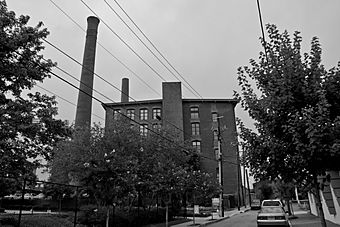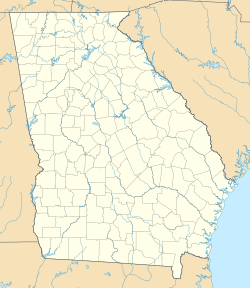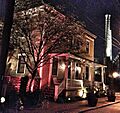Cabbagetown, Atlanta facts for kids
Quick facts for kids |
|
|
Cabbagetown District
|
|

The view of the Cotton Mill Lofts from Carroll Street in Cabbagetown
|
|
| Location | Atlanta, Georgia |
|---|---|
| Built | 1881 |
| Architectural style | Bungalow/Craftsman, Late Victorian, Romanesque |
| NRHP reference No. | 76000623 |
| Added to NRHP | January 1, 1976 |
Cabbagetown is a historic neighborhood in Atlanta, Georgia. It's located on the east side of the city. This area is right next to the famous Oakland Cemetery. The Cabbagetown District is a special part of the neighborhood. It is listed on the U.S. National Register of Historic Places.
Contents
History of Cabbagetown
How Cabbagetown Began
After the Battle of Atlanta, a new factory opened in 1881. It was called the Fulton Bag and Cotton Mill. Cabbagetown was built around this mill. It was a "mill town" where the factory workers lived. This was one of the first textile mills in the South. It mainly made cotton bags for farm products.
The mill was owned by Jacob Elsas. He was an immigrant from Germany. The workers were often poor people from the Appalachian mountains. Elsas built small houses for them. These were mostly one or two-story "shotgun" style homes. The area was first known as Factory Town or Fulton Mill Village. The streets in Cabbagetown are very narrow. They have short blocks and many intersections.
Where Did the Name "Cabbagetown" Come From?
There are a few stories about how Cabbagetown got its name. One idea is that the workers grew cabbages in their front yards. People could often smell cooking cabbage in the neighborhood. At first, people outside the area used the name to be mean. But soon, the people who lived there felt proud of the name.
Another story says a car once spilled cabbages on a main street. Yet another story involves a neighborhood baseball team. Old records also show the name Pearl Park. This was after the daughter of a builder who built houses nearby.
Life in the Mill Town
At its busiest, the mill employed 2,600 people. A long strike happened in 1914-1915. However, the workers did not form a union. For over 50 years, Cabbagetown was a close-knit community. Their lives were centered around the mill. The mill closed in 1977. After it closed, the neighborhood faced tough times.
The mill building itself was added to the National Register of Historic Places in 1976. But the homes around it started to decline.
Cabbagetown's Comeback
In the early 1990s, Atlanta's inner city areas began to improve. Cabbagetown also saw a lot of growth. Artists started moving into the neighborhood in the 1980s. One famous artist was Panorama Ray. He had a photo gallery on Carroll Street. After he passed away in 1997, Carroll Street became a popular spot. It now has restaurants and is a gathering place.
In 1996, the old mill building was renovated. It became the Fulton Cotton Mill Lofts. This was a huge project. In 1999, a big fire damaged part of the lofts. Some nearby homes were also destroyed. But the lofts still opened the next year. In 2008, a tornado hit Atlanta. It damaged parts of the loft complex. Many historic homes and businesses in Cabbagetown were also hurt.
Culture and Art in Cabbagetown
Street Art and Murals
The Krog Street Tunnel connects Cabbagetown and Inman Park. This tunnel has become a famous spot for street art in Atlanta. You can see street art, tags, and graffiti there. There is also art on the wall of the CSX railyard along Wylie Street. The Cabbagetown Initiative has a committee called Wallkeepers. They manage the art in Cabbagetown. In 2012, they allowed artists to paint two murals.
Forward Warrior is an annual event. Artists paint live street art. In recent years, Forward Warrior has covered walls along Wylie Street and Tennelle Street. Dozens of new murals are created. Many of these murals are mapped online.
Neighborhood Festivals
Cabbagetown has a main festival called Chomp and Stomp. It's a bluegrass music and chili festival. It happens every November. In recent years, Chomp and Stomp has included a 5k run. It attracts over 16,000 people.
Images for kids
-
Carroll Street at night, with smokestack of Fulton Bag and Cotton Mill in background







